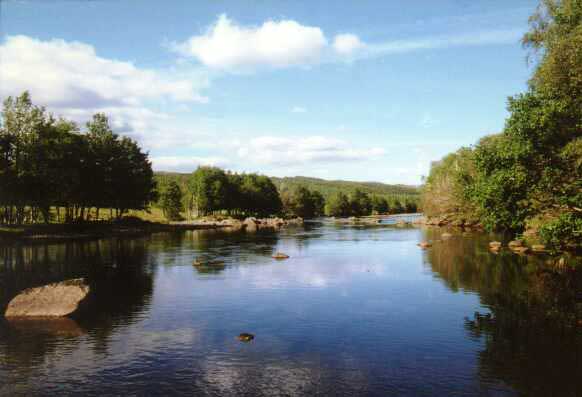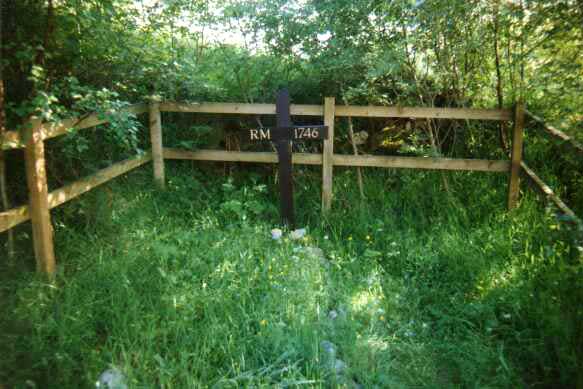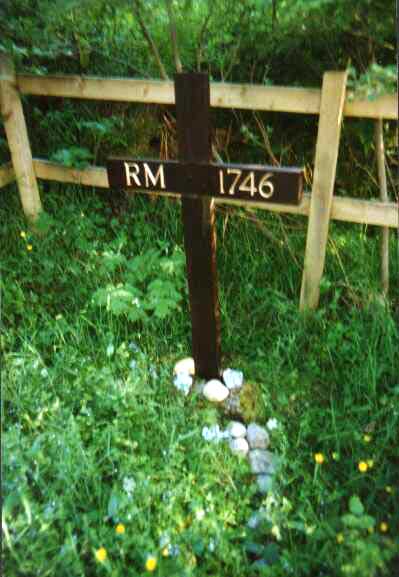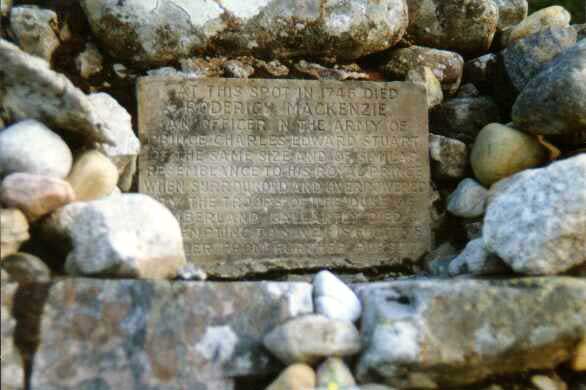THE STORY OF RODERICK MACKENZIE |
A little known hero of the 1745 |
 |
Culloden. Few words provoke such a range of emotions if you’re a Scot. They can range from anger, sadness betrayal, disbelief and a feeling of what might have been! |
 |
| After Culloden Roderick dared not return home to Edinburgh to be with his widowed mother and sisters who stayed at Gray’s Close in the High Street, but instead fulfilled his role as a decoy for the Prince, a role that would ultimately result in Roderick's last great act of bravery. There are varying accounts of Roderick’s final day in late July 1746. Prince Charlie and a few close and trusted supporters had been laying low for a few days up Coire Dho at the head of Glen Moriston in a cave with no retreat to the rear but ample views of the glen and any Redcoats who may be in the area. It was here that it was decided that Roderick would dress as the Prince and allow himself to be visible to the Redcoats and draw them away from the Prince towards Ceannocroc; he managed to lead the Redcoats eight miles away from the cave. Other sources say that Roderick was in fact already down by the burn below Ceannocroc when the Redcoats surprised him and immediately mistook him for the Prince. Whichever source is to be believed, when finally escape was not an option, Roderick turned to face the Redcoats and drew his sword refusing to be taken alive, the ” brave” Redcoats thereupon riddled him with bullets, and he expired with the words on his lips, “You have murdered your Prince!" This selfless act of bravery convinced the Hanoverians that they had at last caught Prince Charles Edward Stuart himself. To quote from 'The Lyon in Mourning' collated by Bishop Forbes in the years following the Battle of Culloden." Mrs Jean Cameron says that Roderick so far deceived them that the Duke of Cumberland went up directly to London in full persuasion the thing were done." The head of our hero was carried in triumph to Fort-Augustus, where Macdonald of Kingsburgh, a prisoner there, refused to identify the head without the body, in turn putting his own life at risk but also knowingly delaying proof of the Prince’s death would give the Prince some much needed time to successfully escape the country. When Cumberland left for England, he took the head with him to be submitted to other witnesses. Eichard Morison, who had been the Prince's valet, and was now under sentence of death at Carlisle, was taken to London to identify the head but it was beyond recognition. The Hanoverians were soon satisfied that the Prince was still indeed alive but Mackenzie's self-sacrifice had slackened for a time the exertions of the troops, and had probably saved the Prince Again quoting from the 'The Lyon in Mourning', Mackenzie fell by the side of the public highway, opposite the lands of Ceanacroc. A cairn marks the spot. The grave in which the headless body was hastily buried lies on the opposite side of the road, and by the side of a small stream called, after Mackenzie, Caochan a' Cheannaich the Merchant's Streamlet. Near it was recently found a sword, probably Mackenzie's. Without any good reason, doubt has been cast on the story by Mr Robert Chambers and Lord Mahon, neither of whom, probably, ever visited the scene of his death. In the story, it is related, the soldiers roamed up and down Glenmoriston, shooting down men, burning homesteads to the ground, stripping women of their clothes, and driving to Fort-Augustus every four-footed animal they could find. Maids and matrons were seized and violated under circumstances of gross brutality. The terror-stricken people fled to the mountains where many of them succumbed to hunger and exposure. Such of them as ventured to the Fort to beg for food were denied the crumbs that fell from the soldiers' table, and were sent away empty by Johnstone (Memoirs) and in the Lyon in Mourning by Macpherson of Cluny, and Mrs Cameron, wife of Dr Archibald Cameron the last Jacobite executed. These all lived at the time of the event. Another contemporary, Dug-aid Graham, the rhyming historian of The Forty-Five, gives it in the following lines: |
"Rod'rick Mackenzie, a merchant-man, |
There is no doubt that Roderick's noble sacrifice allowed the Young Pretender many more valuable days to escape from being trapped in Glen Moriston where he would have most certainly met the same fate. One of the bravest deeds of the '45 and hopefully you’ll agree, one who should be remembered as a brave man, an unselfish man and a hero. |
 |
Location |
| There is an annual ceremony which takes place during the last fortnight in July to commemorate Roderick Mackenzie. If you are heading up Glen Moriston on the A887 from Invermoriston you will find the site marked by a large cairn on the left hand side of the road about two miles before you get to the junction with the main A87 from Invergarry\Fort William. If, as is likely, you are coming up the A87 from Invergarry\Fort William you will need to make a short detour back down the A887 towards Invermoriston. It is no more than a couple of miles and you may decide whether it is worth it when you have read the story of Roderick MacKenzie. Roderick’s cairn lies immediately south of the road. It bears a plaque giving full details of the incident. The actual grave itself however, lies somewhat neglected about 100m diagonally westwards across the road at the bottom of a deep hollow. A cross on it bears the simple inscription: |
 |
"AT THIS SPOT IN 1746 DIED |
 |
© Paisley Tartan Army 2008-09
